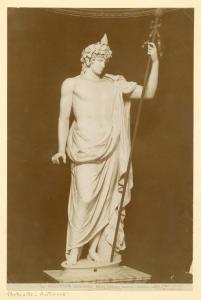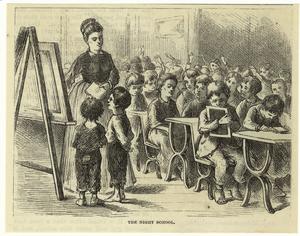By Miriam B. Medina

(Continued from previous page)
2) The Feast of Giglio di Sant' Antonio
Originally this feast was commenced in the 1880's in the town of Brusciano, Italy, which is about 20 miles outside of Naples. Francisco Vivolo, a local resident of Brusciano, prayed to Sant'Antonio (Saint Anthony) to help heal his deathly ill son. He promised Saint Anthony that he would have a Gigli constructed in his honor and dance with it in the streets of Brusciano if his prayer should be answered, in the same manner as the town's people of Nola, Italy honored San Paolino di Nola. Vivolo's prayers were answered, and thus the dancing of the Gigli in Brusciano was commenced.
Around the early 1900's many of the families from the town of Brusciano migrated to East Harlem, New York, bringing their cherished traditions with them, including the annual Dance of the Giglio Festival in honor of Sant'Antonio.
"For those unfamiliar with the Giglio (pronounced JEEL-YO)-it is a 75 to 85 foot tall wooden structure weighing approx 8,000 lbs with a paper-mache face adorned with beloved saints and colorful flowers. On the platform just above the base of the Giglio sits a multi-piece band along with several singers. The music is an instrumental part of the dancing of the Giglio as it inspires the Lifters (also known as the '"Paranza" in Italian) to take on the burdening weight of the Giglio and band and dance it in harmony to the music being played." The lifting of the Giglio requires over a 100 men working in unity.
Members of the Vivolo family have been involved with the celebration of the Giglio Feasts in East Harlem for many years.
Francisco Vivolo had three sons and two daughters. Of the sons, Rocco was the oldest, Gioacchino was the second son, and then there was Antonio, the youngest child who was healed. According to Francisco Vivolo's great-grandson, Phil Bruno, a native of East Harlem, Rocco was the first one to come to America. He lived on Mulberry Street. He then moved to an apartment at 348 East 106th street sometime in 1906. Then Phil Bruno's grandfather, Gioacchino, came in December, 1907. Gioacchino sent for his wife and child and settled in an apartment at 2053 1st Avenue. He lived there until 1958 when the tenements were torn down. Phil Bruno also lived in that same tenement. Shortly after, the first Giglio feast was celebrated on 106th street in the year 1909. Gioaccino became the first Capo Paranza (Head of the lifters). That is a position that commands the highest respect in a Giglio celebration. Several years later in 1918, the Bruscianese society was formed with Rocco as the President. The first celebration of the Giglio feast under the Bruscianese Society administration was in 1918.
Sometime during the 20's and 30's many Giglio's were built and carried on 106th street during the feast along with a boat. The Bruscianese Society, who was running the feast on 106th street, was only able to do it until the mid 1930's.
A statue of Saint Anthony was sent to Phil Bruno's grandparents from a relative who was a priest in Brusciano. This statue was used in the feast from 1925 until 1955. It is still in his family today. Phil Bruno's grandparents sat in front of the statue during every feast that was celebrated on 106th street along with his mother, aunts and uncle until 1955, the last Giglio feast on 106th street. Then in 1957 the Giglio Feast moved to 108th street where it continued until 1971. After a 29 year hiatus the feast returned in 2000, and since then continues to be celebrated annually. It is as strong and vibrant as ever. I should know, I was there in 2010.
As he carries on a family tradition, Phil Bruno's passion for the old neighborhood and the celebration of its feasts is palpable. He has been and still is a member of Our Lady of Mt. Carmel Holy Name Society. He attends the monthly communion meetings at Mt. Carmel located at 115th street. Phil is also a board member and Capo at the time of the feast, and Lieutenant for the Giglio Society of East Harlem in charge of the Giglio restoration.
Among the many contributors that have made possible the success of both feasts, Bob Maida is by far one of the greatest. His love, tireless energy and passion for the old neighborhood is strong and contagious. Bob Maida is a volunteer photographer who willingly and magnanimously has given of his time and money to capture images of the feasts with actual emotions that are impossible to communicate with words. Year after year, these images have been added to the already swollen coffers containing Italian Harlem memories.
Although many former residents from Italian Harlem have passed on, it is their children and grandchildren that continue to support the memories of the old neighborhood, preserving the culture and bonds of friendship that have been passed down from one generation to another. They have experienced the best of both worlds while proudly retaining aspects of their culture, celebrating the heritage that their ancestors once brought to their newly adopted home.
If you want to learn more about Miriam's writing, her old neighborhood's religious feasts, or if you want to see the dancing of the giglio and feel the jubilation of the moment, please visit:
The
History Box for an unforgettable experience.
To contact: miriammedina@earthlink.net or miriam@thehistorybox.com


 A.) Getting To Know Mimi (B.) N.Y.C. History (C.) Italian Harlem(D.) Spanish Harlem (E.) Black Harlem (F.) New York State (G.) Tenement Living: Social Issues Of Urban Life (Poverty, Crime&Vice, Homelessness, Group Conflicts, Diseases, Gays&Lesbians: Gender Identity, Domestic Violence, Drug&Alcohol Abuse, Police Brutality )
A.) Getting To Know Mimi (B.) N.Y.C. History (C.) Italian Harlem(D.) Spanish Harlem (E.) Black Harlem (F.) New York State (G.) Tenement Living: Social Issues Of Urban Life (Poverty, Crime&Vice, Homelessness, Group Conflicts, Diseases, Gays&Lesbians: Gender Identity, Domestic Violence, Drug&Alcohol Abuse, Police Brutality )























